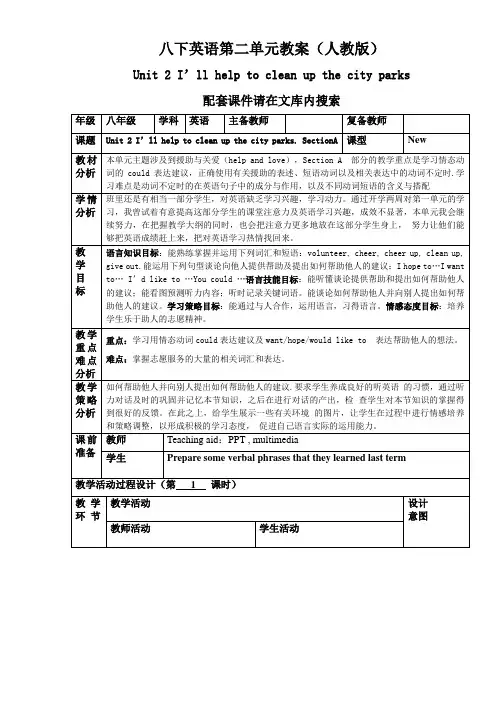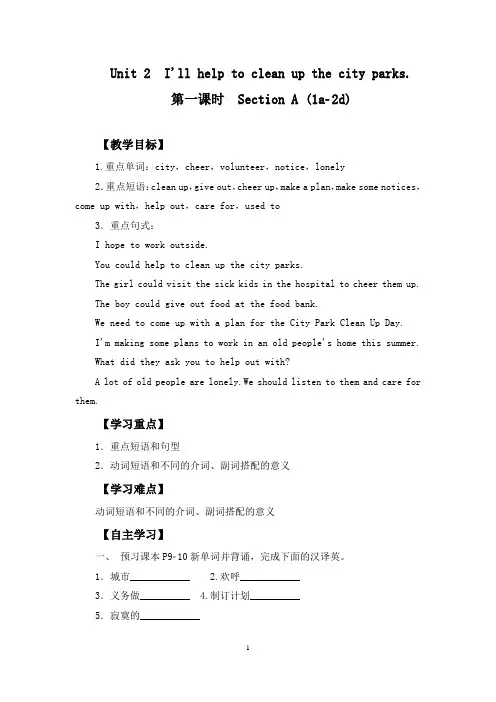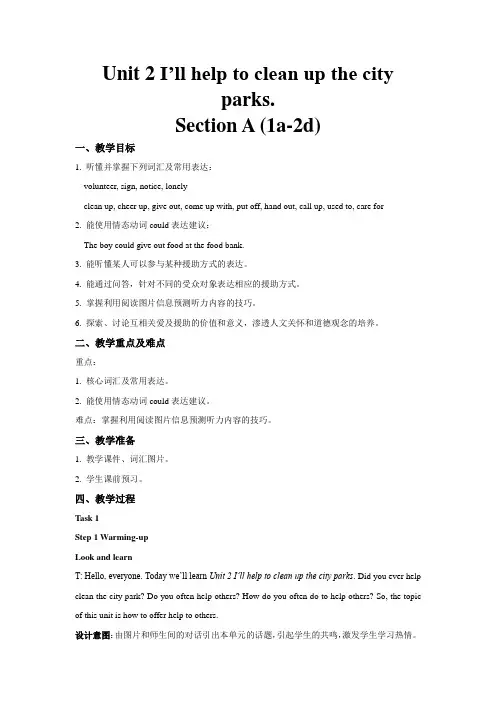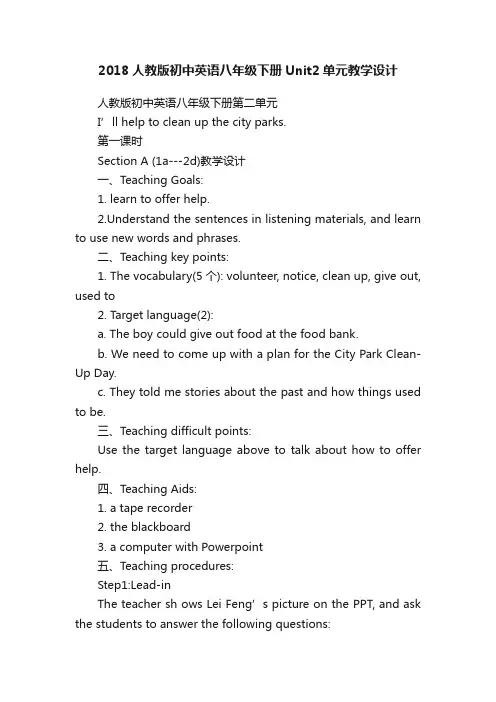八年级下英语第二单元第一课时教案
人教版八下英语Unit2全单元教案

1.This weekend the Association of Susong Volunteer is going to have a volunteering activity. Here are the four activities.And each group of you will take part in one of the activities. But what could
学情分析
班里还是有相当一部分学生,对英语缺乏学习兴趣,学习动力。通过开学两周对第一单元的学习,我曾试着有意提高这部分学生的课堂注意力及英语学习兴趣,成效不显著,本单元我会继续努力,在把握教学大纲的同时,也会把注意力更多地放在这部分学生身上, 努力让他们能够把英语成绩赶上来,把对英语学习热情找回来。
教
学
目
标
语言知识目标:能熟练掌握并运用下列词汇和短语:volunteer, cheer, cheer up, clean up, give out.能运用下列句型谈论向他人提供帮助及提出如何帮助他人的建议:I hope to…I want to… I’d like to …You could …语言技能目标:能听懂谈论提供帮助和提出如何帮助他人的建议;能看图预测听力内容;听时记录关键词语。能谈论如何帮助他人并向别人提出如何帮助他人的建议。学习策略目标:能通过与人合作,运用语言,习得语言。情感态度目标:培养学生乐于助人的志愿精神。
Greet the teacher.
Get ready for the new lesson
ห้องสมุดไป่ตู้教学
环节
教学活动
设计
意图
To arouse Ss’ imagination and help them love their hometown better.
人教版八年级英语下册第二单元教案[001]
![人教版八年级英语下册第二单元教案[001]](https://uimg.taocdn.com/4cbe66370a4c2e3f5727a5e9856a561252d321f2.webp)
Unit 2 I’ll help to clean up the city parks. 教材解读本单元的核心话题为“volunteering”,围绕着主动提供帮助,以观察图片、听力理解、阅读理解等训练方式和独立学习、合作交流、完成任务等形式完成目标语言的输入,学习“I’d like…”“You could...”等句型和一些重要动词短语为主要学习内容,并且设置任务型综合性语言实践活动,让学生在交际活动中,学会如何正确地用英语表达自己的意见和建议,重在培养学生的习得语言运用能力、实践能力、合作能力及创新意识,通过本单元的学习,使学生能向别人提供帮助,争做一名志愿者。
单元目标一、知识及技能1. 掌握重点单词和短语:clean up,cheer up,give out,put off,set up,think up,take after,fix up,give away,put up,hand out,work out,at once2. 掌握情态动词could,should的用法;用should或could提出建议并对别人的建议作出评价。
3. 掌握重点句型:(1) I’d like to / I want to / I decide to…(2) You could…(3) We should…二、过程及方法交际法:学外语的主要目的不是在掌握语言结构本身,而是在发展学生的交际能力,让他们在创设的交际情景中学会知识,以便能再运用于现实交际活动中。
情境创设法:创设情境为学生营造感受英语,说英语的氛围。
三、情感态度及价值观在授课过程中渗透助人就是助己、助人收获快乐的情感目标,使学生在谈论如何为别人提供帮助的对话中能意识到尽己所能帮助他人、乐于奉献是一种良好的品德,培养学生为他人着想、热爱公益事业、乐于助人的优良品质。
教法导航新课程的背景下,要求学生以“任务”为前提,进行有条件、有目的的听、说、读、写活动。
【精选】人教版八年级下册英语Unit2(第二单元)优秀教案

Unit 2 I'll help to clean up the city parks.第一课时Section A (1a2d)【教学目标】1.重点单词:city,cheer,volunteer,notice,lonely2.重点短语:clean up,give out,cheer up,make a plan,make some notices,come up with,help out,care for,used to3.重点句式:I hope to work outside.You could help to clean up the city parks.The girl could visit the sick kids in the hospital to cheer them up.The boy could give out food at the food bank.We need to come up with a plan for the City Park Clean Up Day.I'm making some plans to work in an old people's home this summer.What did they ask you to help out with?A lot of old people are lonely.We should listen to them and care for them.【学习重点】1.重点短语和句型2.动词短语和不同的介词、副词搭配的意义【学习难点】动词短语和不同的介词、副词搭配的意义【自主学习】一、预习课本P910新单词并背诵,完成下面的汉译英。
1.城市____________ 2.欢呼____________3.义务做__________ 4.制订计划__________5.寂寞的____________二、认真预习1a2d找出下列短语和句型。
八年级第二单元英语下册教师上课教案Unit 2 第1课时教案(八下)

Unit 2 I’ll help to clean up the cityparks.Section A (1a-2d)一、教学目标1. 听懂并掌握下列词汇及常用表达:volunteer, sign, notice, lonelyclean up, cheer up, give out, come up with, put off, hand out, call up, used to, care for2. 能使用情态动词could表达建议:The boy could give out food at the food bank.3. 能听懂某人可以参与某种援助方式的表达。
4. 能通过问答,针对不同的受众对象表达相应的援助方式。
5. 掌握利用阅读图片信息预测听力内容的技巧。
6. 探索、讨论互相关爱及援助的价值和意义,渗透人文关怀和道德观念的培养。
二、教学重点及难点重点:1. 核心词汇及常用表达。
2. 能使用情态动词could表达建议。
难点:掌握利用阅读图片信息预测听力内容的技巧。
三、教学准备1. 教学课件、词汇图片。
2. 学生课前预习。
四、教学过程Task 1Step 1 Warming-upLook and learnT: Hello, everyone. Today we’ll learn Unit 2 I’ll help to clean up the city parks. Did you ever help clean the city park? Do you often help others? How do you often do to help others? So, the topic of this unit is how to offer help to others.设计意图:由图片和师生间的对话引出本单元的话题,引起学生的共鸣,激发学生学习热情。
Watch and thinkT: As a student, what can you do to offer help? There’re also some organizations offering help to people i n need in our country or in the world. Let’s watch a short video. You can think about what the video discusses while watching.设计意图:吸引学生注意力,进一步渗透单元话题。
2018人教版初中英语八年级下册Unit2单元教学设计

2018人教版初中英语八年级下册Unit2单元教学设计人教版初中英语八年级下册第二单元I’ll help to clean up the city parks.第一课时Section A (1a---2d)教学设计一、Teaching Goals:1. learn to offer help.2.Understand the sentences in listening materials, and learn to use new words and phrases.二、Teaching key points:1. The vocabulary(5个): volunteer, notice, clean up, give out, used to2. Target language(2):a. The boy could give out food at the food bank.b. We need to come up with a plan for the City Park Clean-Up Day.c. They told me stories about the past and how things used to be.三、Teaching difficult points:Use the target language above to talk about how to offer help.四、Teaching Aids:1. a tape recorder2. the blackboard3. a computer with Powerpoint五、Teaching procedures:Step1:Lead-inThe teacher sh ows Lei Feng’s picture on the PPT, and ask the students to answer the following questions:Who is this man? Why is he so famous in China?(the answer will be mostly like this: he is famous because he always helps others.)Step2: Asking-and-answering activities with the target language(Show pictures on the PPT about volunteering work.)Step3: PairworkNow, the teacher asks the Ss to think about what they can do to help others.S1: I can read to the old.S2: I can help my parents to clean up the living room.S3: …Step4: listening1page 9, 1b.play the tape and ask the students to listen and number the ways the boy and the girl could help others.page9,1cPractice the conversation in the picture above. Then make other conversations using the information in 1b. Then give Ss five minutes to make conversations.(two Ss a pair)Step 5: Listening 2page10,2a,2b1.listento yhe tape and check the things they are going to do to tellpeople about it.2.listen again, and fiil in the blanks.a.We need to _______ _______ _______a plan to tell people about the citypark clean-up.b.Clean up day is only two weeks from now. We can’t________ _______making a plan.c.We could ________ _______ signs.d.Let’s make some notices, too. Then I’ll _______ them_______ a fterschool.e.We could each _______ _______ 10 students and ask them to come. Step 6: Roleplay the conversation.(1)help oneself to sth.随便吃食物等。
2020年春人教新目标英语八年级下册Unit2-全单元教案

2020年春人教新目标英语八年级下册八年级英语学科Unit2 I’ll help clean up the city parks学生姓名:班级:班课题:Section A(1a—2c)课型:新授课第1 课时编制人:审核人:使用时间:年月日(星期)【学习目标】1.重点词汇用法及短语动词用法。
2.学会“I will…”,“I would like…”等句型,向别人提供帮助。
【重点、难点】重点词汇用法及短语动词用法。
【导学指导】温故知新:给下列单词1)-6)加上-ful, 7)-10)加上-less,并写出其汉语意思。
1)use __ 2)care 3) success 4)beauty 5)color 6)wonder __ 7)home ______ 8)help ___ 9)care ____ 10)use _____【自主预习】1.译单词:1)饥饿2)志愿者_______________3)标牌4)通知_________2.译短语:1)使振奋起来______ 2)分发_____ 3)志愿做某事_____________________ 4)打扫干净_____________5)想出____________ 6)清洁日____ 7)sick children _____ 8)at the food bank __ 9)after-school study program10)推迟__ 11)make a plan 12)张贴标志___________________13)分发____________ 14) call up sb.___________ 15)from now______ 16)无家可归的人们____ 3. 自主预习完成1a的任务。
【听力导学】1.认真阅读1b各句子,弄懂大概含义,并猜一猜空格会填什么内容。
听录音,完成1b,并核对答案。
2.看懂2a中五幅图片的内容。
听录音,勾出所涉及到的图片。
2020年春人教新目标英语八年级下册Unit2全单元教案(无答案)
2020年春人教新目标英语八年级下册Unit2 I’ll help to clean up the city parks.第一课时(Section A 1a- 2c)课型:新授时间:主备人:审核人:审定人:组别:八年级英语组班级:姓名:[一.学习内容]:Unit2 I’ll help to clean up the city parks. (1a--2c)[二.学习目标]:1.能正确朗读并准确掌握本单元的生词及短语。
2.初步掌握向他人求助或提供帮助的句子。
[三.教学重点、难点]重点: 初步掌握向他人求助或提供帮助的句子。
难点:初步掌握向他人求助或提供帮助的句子。
1.预习P1-3的单词及短语2.熟悉相关教材内容并对不懂的地方进行标记。
一英汉互译:1.clean up the city parks2.visit Sick Children3.在医院4. 在外面工作5. 使他们高兴6。
分发食物7.在食品救济中心_____8.在课外学习活动小组教孩子9. 想出10清扫日______ 11离现在有两周_____12.推迟13制定计划__ ____ 14.做一些公告牌15.放学之后16.给某人打电话17.吃午餐二.请同学们认真阅读与本课时相关的句子和对话,并试着翻译下列的句子:1、这个女孩可以去医院探望生病孩子是他们高兴2、这个男孩可以在食品救济中心分发食物。
3、这个女孩可以志愿在课外学习活动小组教孩子。
4、这个男孩可以帮助打扫城市公园。
5、我们需要想出一个计划来告诉人们关于这个城市清扫日的事。
6、我们不能推迟制定计划了。
7、我们可以张贴标志牌。
三、请同学们认真朗读与本课时相关的对话并模仿该对话,根据自己实际情况写一个对话。
让学生小组回忆以前所学的有关于委婉(一)教学步骤1. 解读学习目标,学习新词汇2.教师通过玩游戏”Touch your ---”,然后引出询问向他人求助或提供帮助的句子:A: I like reading books.What could you do? B:You could volunteerin an after-school study program to teach kids. (选出写的好的小组进行加分)并核查预习案3.给学生5分钟的时间,让他们模仿1a中的短语进行相互问答练习并把他们编的对话写下来,听听力完成1 b,然后进行相互问答练习。
八年级英语下册Unit2 Section A教案人教版
八年级英语下册Unit2 Section A教案Topic: What’s the matter?Language goal: In this unit, students learn to talk about health and give advice.New language:1.The parts of the body.2. What’s the matter? I have aheadache/stomachache/toothache/sore throat. Teaching aid: Tape-recorder. New word card.Period: the first period.Teaching procedure:Step1: Presentation1.Say hello to the students. Then ask the students: Howmany parts of the body can you name? Help the students to answer by pointing to the head, the hand, the leg and the foot.ing the word cards to teach the new words, eg: Takeout the word card of “arm”. Point to my arm, and say: This is my arm. Then write the word on the blackboard and read them loudly.3.Get the students to read the words in pairs. Practicethe words like this:S1: (Point to his head) What’s this?S2: It’s your head. Where’s your ear?S1: It’s here. (Point to the ear)Step 2: 1a1.Ask students to look at the pictures of the studentsnumbered 1 through 5. Several body parts are marked with the letters a-m. Write the correct letter after the name of each body part on the list.2.Point out the sample answer “k”before the word“arm”.3.Ask students to complete the activity individually.4.Check the answers.e the word cards to consolidate the new words. Ask thestudents to read the words and point to the part of the body.Step3: Learn the illness.1.Act out an illness. For example:Hold the head and say: I have a headache. Get the students to repeat and explain the meaning of the word and sentence.2.Point to one of the people in the picture and ask:What’s the matter? Then answer: He has a stomachache.Get the students repeat. Then ask the other people and learn the illness such as: have a cold, have a toothache, have a sore throat, etc.Step4: 1b1.Ask the students to look and read the names in 1b.2.Say, you will hear 5 conversations. Look at the pictureand find the people that are being talked about. Write the number next to their name here.3.Play the recording twice and find the correct answers. Step5: 1c Pairwork.1.Point out the sample conversation in the box. Ask twostudents to read it to the class.2.Say, now work with a partner. Make your ownconversations about the pictures.3.As they talk, move around the room and monitoring theirwork.4.Ask several students to present their dialogues. Homework:write the new words.附:教案特色自我评价这是八年级英语下册第二单元《 What’s the matter 》Section A第一课时的一篇教案。
新人教版八年级英语下册Unit2(1)教案
新人教版八年级英语下册Unit2(1)教案
教学目标
1. 研究并掌握本课时的重点单词和短语。
2. 学会使用本课时的重点句型进行日常交际。
3. 能够阅读并理解与本课时主题相关的文章。
4. 提高学生的听说读写能力。
教学重点
1. 重点单词和短语的研究。
2. 重点句型的练和应用。
教学准备
1. 多媒体设备。
2. 板书工具。
教学过程
导入
1. 利用图片或实物引入本课时的主题,激发学生的研究兴趣。
基础知识研究
1. 分组教学:教师通过多媒体展示本课时的重点单词和短语,
并进行发音和拼写的练。
学生根据教师的指导进行跟读和模仿。
语言运用
1. 集体合作:教师以问答形式引导学生运用本课时的重点句型
进行对话练,加深对句型的理解和掌握。
阅读理解
1. 小组活动:将学生分成小组,给每个小组发放相关阅读材料,让学生进行阅读并回答相关问题。
听力训练
1. 教师播放本课时相关的听力材料,学生仔细听后,回答相关
问题。
拓展延伸
1. 学生根据所学句型和词汇,编写一个关于本课时主题的简短
对话,并与同伴进行表演。
总结反思
1. 教师对本节课进行总结,提醒学生本课时的研究重点和难点。
作业布置
1. 布置相应的作业,例如完成课后题,或写一篇关于本课时主
题的短文。
板书设计
使用多媒体展示相应单词、短语和句型,并根据教学内容进行
板书。
人教版英语八年级下册Unit2SectionA1a2d教学设计
4.鼓励学生互相交流、讨论作业,共同提高。
2.邀请学生分享他们对这些图片的理解和感受,从而引出本节课的主题:“帮助他人,回馈社会”。
3.教师提出问题:“Can you tell me what you did to help others in the past?”,让学生运用一般过去时态分享自己的经历,为新课的学习做好铺垫。
(二)讲授新知
2.学习并运用一般过去时态描述过去发生的事情,巩固对一般过去时态的掌握。
3.能够理解并运用一般将来时态描述将来的计划或打算。
4.提高学生的听说能力,通过听力练习,提高学生对英语语音、语调的敏感度,培养良好的英语语感。
5.培养学生的阅读理解能力,通过阅读课文,理解文章的主旨大意,抓住关键信息。
(二)过程与方法
(三)情感态度与价值观
1.培养学生的社会责任感,使他们意识到帮助他人、回馈社会的重要性。
2.增强学生的团队合作意识,让他们明白团队协作的重要性。
3.培养学生的爱心和同情心,使他们关心他人,乐于助人。
4.引导学生树立正确的人生观和价值观,关注社会问题,积极参与社会公益活动。
5.培养学生的跨文化意识,让他们了解并尊重不同的文化背景,增强国际视野。
b. How did you feel about it?
c. What are you planning to do to help others in the future?
2.各小组进行讨论,并记录下讨论成果,准备进行课堂展示。
(四)课堂练习
1.教师设计以下练习题,帮助学生巩固所学知识:
a.填空题:根据句意,用适当的时态和词汇完成句子。
- 1、下载文档前请自行甄别文档内容的完整性,平台不提供额外的编辑、内容补充、找答案等附加服务。
- 2、"仅部分预览"的文档,不可在线预览部分如存在完整性等问题,可反馈申请退款(可完整预览的文档不适用该条件!)。
- 3、如文档侵犯您的权益,请联系客服反馈,我们会尽快为您处理(人工客服工作时间:9:00-18:30)。
I’d like to work outside.
I’ll help clean the city park.
You could give out food at a food bank.
教学难点
学会提供帮助的基本句型
教学准备
多媒体课件
教学过程
个人再探索
Step 1Warming up
3. We could ___ ___ signs.
4. Let’s make some notices, too. Then I’ll ____ them ____ after school.
5. We could each ____ ___ 10 students and ask them to come.
e.g.I don’t feel lonely because I made new friends here.
我不觉得孤独因为我交了新朋友。
ed to曾经,过去
e.g.Jack used to be short, but now he’s tall.杰克过去很矮,但现在高了。
Step 3 Discussion
能掌握以下句型:
① Youcould help to clean up the city parks.
② We should listen to them and care for them.
2)能了解以下语法:
情态动词could, should的用法;用should或could提出建议并对别人的建议作出评价。如何表达主动提供帮助。
②Help clean up the city park.
③Visit the old people in the old people’s home.
④Help young kids to learn English.
Step 4Listening
1. T: Tell Ss to read the sentences in the chart. Make sure they know the meaning of thesentences.
4.volunteerv.义务劳动,自愿做volunteer to do sth.义务自愿做某事
e.g.Many people volunteer to work on the farm.很多人志愿到农场去工作。
5.clean up打扫;清除
e.g.The students take turns to clean up their classroom.学生们轮流打扫教室。
Answers: b, c, e
2.2b:
1. Let Ss read the sentences below. Explain some main sentences for the Ss. Make sure they know what to do.
2. Play the recording for the Ss to write the correct words in the blanks.
2. Let one pair to read out their conversation first.
e.g.
A: We need to come up with a plan for the City Park Clean-Up Day.
B: Let’s have lunch first.
A: No, we need to start now. Clean-Up Day is only two weeks from now.
____________________________________
Answers:She’s going to work in an old people’s home.
Reading the newspaper or just talking to the old people.
2. Read the conversation after the teacher.
2.noticen.公告牌;通告;布告
e.g.Please read the list on the notice board.请读公告板上的名单。
3.signn.标志;信号
e.g.Look around, we could see no sign of life.
环顾四围,我们看不出一点生命的迹象。
3.Practice the conversation with their partner. Then let some pairs to act out the conversation.
Step 9 Language points
1. They told me stories about the past and how things used to be.
1. Read the conversations and answer the two questions:
①Where’s Helen going to work this summer?
__________________________________
② What did Tom do to help the old people?
used to do sth.过去常常做某事;表示过去习惯性、经常性的动作或状态,暗指现在已经不存在。used无人称和时态的变化。
e.g. I used to go to theYouthCenter. But I have no time now.
B: You’re right. We can’t put off making a plan. As we talk, I’ll write down all our ideas. Then we can decide which ideas are best.
A: Let’s make some notices, too. Then I’ll hand them out after school.
2.情感态度价值观目标:
在授课过程中渗透助人就是助己,助人收获快乐的情感目标,使学生在谈论如何为别人提供帮助的对话中能意识到尽己所能,帮助他人,乐于奉献是一种良好的品德,培养学生为他人着想,热爱公益事业,乐于助人的优良品质。
教学重点
1)掌握这些短语动词的构成和用法:clean up, city, cheer, cheer up, give out, volunteer, notice, used to, lonely
A:I hope to work outside.
B:You could help to clean up the city parks.
……
3. Let some pairs act out their conversations.
Step6Listening
1.2a:
T:A group of students are planning aCityParkClean-up Day. Listen and check (√) the things they are going to do to tell people about it.
3. Play the recording again to check the answers.
Answers: 1. come up with 2. put off 3. put up 4. hand, out 5. call up
Step 7Pair work
1.2c.Tell Ss to make a conversation using the information in2aand 2b.
1. We need to _____ ___ ____ a plan to tell people about the city park clean- up.
2. Clean-up Day is only two weeks from now. We can’t ___ ___ making a plan.
1. Look at the pictures in2a. Discuss the things they are going to do.
2. Play the recording for the Ss to listen and check the pictures.
3. Play the recording again to check the answers.
___ The boy could give out food at the food bank.
___ The girl could volunteer in an after-school study program to teach kids.
___ The boy could help to clean up the city parks.
1.1a.Look at the ways you could help others. Then list other ways.
2. Ss discuss with their partners and write the ways one could help others:
①Help plant trees by the river.
6.give out分发;散发
e.g.Please help me give out these test papers.请帮我将这些试卷发下去。
7.cheerv.欢呼;喝彩
e.g.Cheer up. The news isn’t too bad.振作起来,消息还不算太坏。
8.lonelyadj.孤独的;寂寞的
